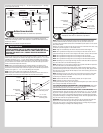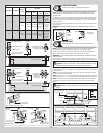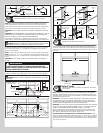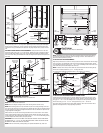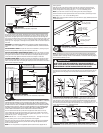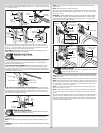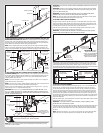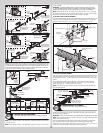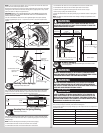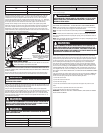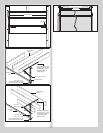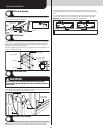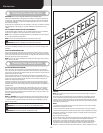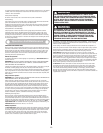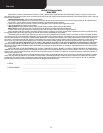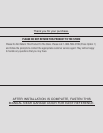
Cleaning Your Garage Door
IMPORTANT: DO NOT USE A PRESSURE WASHER ON YOUR GARAGE DOOR!
While factory-applied finishes on garage doors are durable, it is desirable to clean them on
a routine basis. Some discoloration of the finish may occur when a door has been exposed
to dirt-laden atmosphere for a period of time. Slight chalking may also occur as a result of
direct exposure to sunlight.
Cleaning the door will generally restore the appearance of the finish. To maintain an aestheti-
cally pleasing finish of the garage door, a periodic washing of the garage door is recom-
mended.
THE FOLLOWING CLEANING SOLUTION IS RECOMMENDED:
A mild detergent solution consisting of one cup detergent (with less than 0.5% phosphate)
dissolved into five gallons of warm water will aid in the removal of most dirt.
NOTE: The use of detergents containing greater than 0.5% phosphate is not recommended
for use in general cleaning of garage doors.
NOTE: Be sure to clean behind weatherstrips on both sides and top of door.
CAUTION: NEVER MIX CLEANSERS OR DETERGENTS WITH BLEACH.
GLASS CLEANING INSTRUCTIONS
Clean with a mild detergent solution (same as above) and a soft cloth. After cleaning, rinse
thoroughly.
ACRYLIC CLEANING INSTRUCTIONS
Clean acrylic glazing with nonabrasive soap or detergent and plenty of water. Use your bare
hands to feel and dislodge any caked on particles. A soft, grit-free cloth, sponge or chamois
may be used to wipe the surface. Do not use hard or rough cloths that will scratch the acrylic
glazing. Dry glazing with a clean damp chamois.
NOTE: Do not use any window cleaning fluids, scouring compounds, gritty cloths or solvent-
based cleaners of any kind.
Painting Your Garage Door
SURFACE PREPARATION FOR PAINTING
Wax on the surface must be removed or paint peeling/ flaking will result. To remove this
wax, it will be necessary to lightly scuff the surface with a fine steel wool pad saturated with
soapy water. A final wipe and rinse should be done with clean water only to remove any loose
particles and any soapy film residue.
Surface scratches, which have not exposed the metal substrate, can be lightly buffed or
sanded with 0000 steel wool or no. 400 sand paper to create a smoother surface. Care must
be taken to not expose the substrate under the paint. Once the substrate is exposed, the
likelihood for rusting is greatly increased.
If substrate is exposed, it must be treated to prevent rust from forming. Sand the exposed
area lightly and paint with a high quality metal primer specifically intended for galvanized
surfaces to protect the area from corrosion. Allow for drying time on primer can label before
applying topcoat.
The surface of the factory-applied finish, that is being painted, must not be too smooth, or
the paint will not adhere to it. It is advisable to test in an inconspicuous area, to evaluate
adhesion. If poor adhesion is observed, surface preparation for painting the factory-applied
finish must be repeated until desired results are achieved. Again, care must be taken to not
expose the substrate under the paint.
CAULKING:
NOTE: After SURFACE has been properly prepared use acrylic latex plus silicone caulk. Fol-
low caulking label directions explicitly. It must be allowed to dry thoroughly prior to painting.
1. Caulk the top edge of all horizontal stiles to the section (Top, Intermediate(s), Lock and
Bottom sections) surface.
CAUTION: DO NOT CAULK BOTTOM EDGE OF ANY HORIZONTAL STILES.
CAUTION: DO NOT CAULK VERTICAL OR DIAGONAL STILES.
2. Caulk exterior overlay to glass in all lite cutouts for lited sections.
PAINTING:
NOTE: When painting the section, the paint must not seal the bottom edge of any stiles to
the section surface.
After surface has been properly prepared, it must be allowed to dry thoroughly, and then
coated immediately with premium quality latex house paint. Follow paint label directions
explicitly. Oil base or solvent base paints are not recommended. Please note that if substrate
is exposed and not properly primed, painting with latex paint may cause accelerated rusting
of the steel in the exposed area.
NOTES:
1. Re-painting of finish painted steel doors cannot be warranted, as this condition is totally
beyond the door manufacturer’s control.
2. Consult a professional coatings contractor if in doubt about any of the above directions.
3. Follow directions explicitly on the paint container labels for proper applications of coatings
and disposal of containers. Pay particular attention to acceptable weather and temperature
conditions in which to paint.
Wood (Preparation and Painting)
These instructions apply to all Wood Doors produced and sold by Wayne-Dalton. The exterior
surfaces, as well as all edges must be properly painted and maintained if satisfactory
performance is to be achieved. The purpose for painting is to both protect and beautify
the substrates. These requirements for finishing are intended to achieve both functions for
reasonable service life of wood doors. Wood doors must be completely finished prior to
installation, to ensure that the interior and exterior surfaces, as well as all edges of the doors
19
Maintenance



